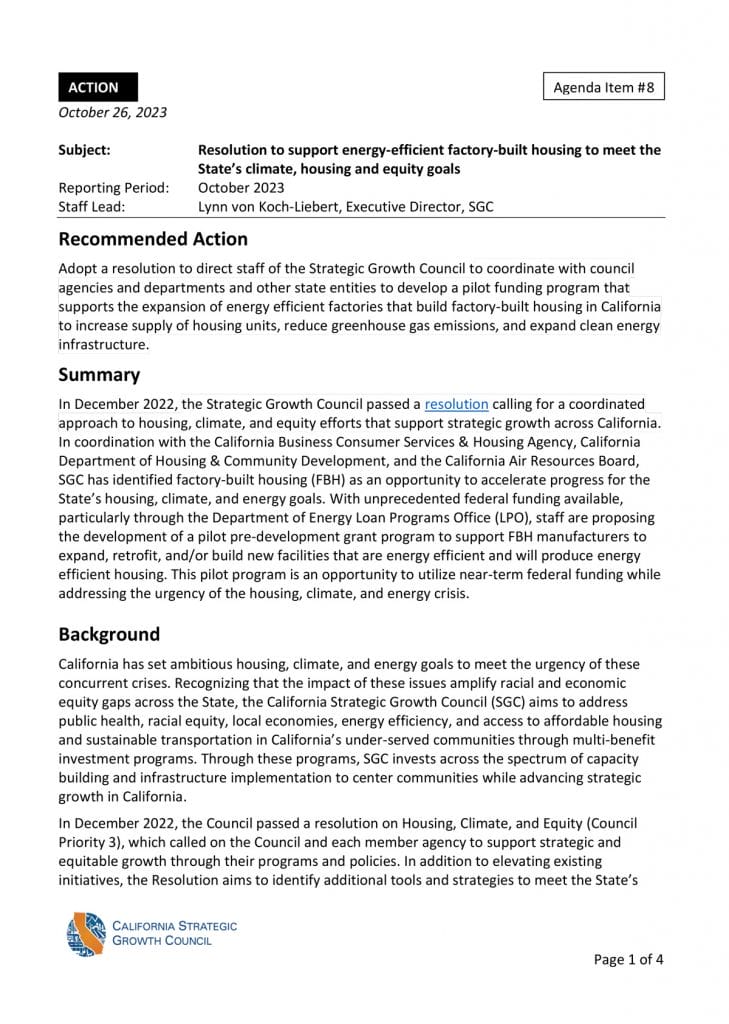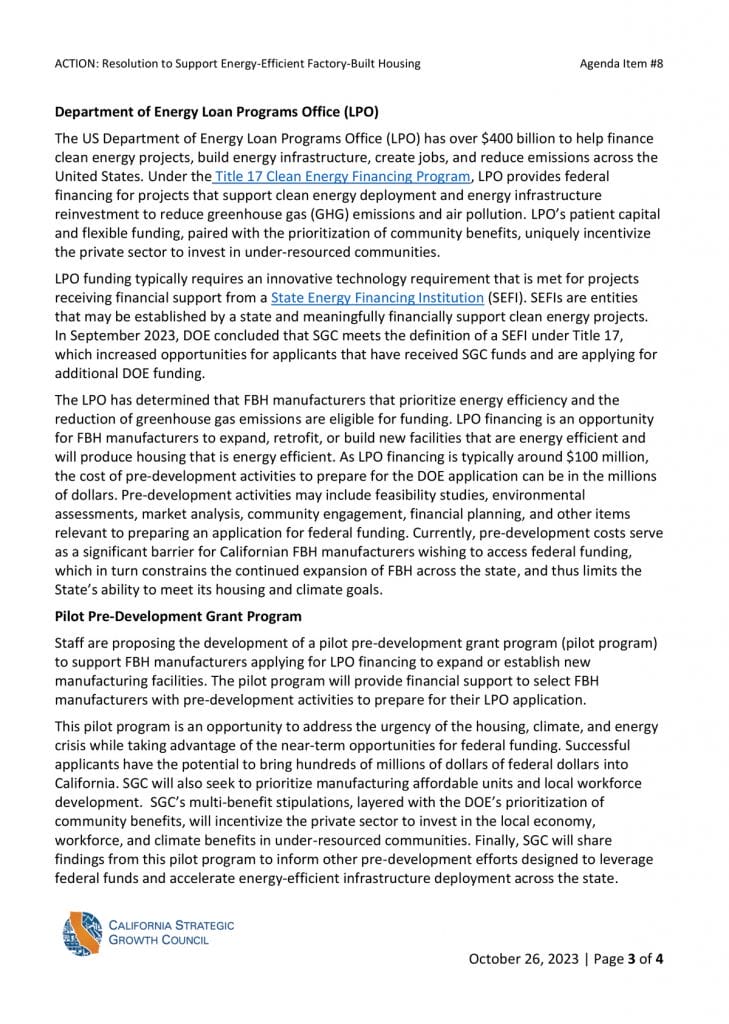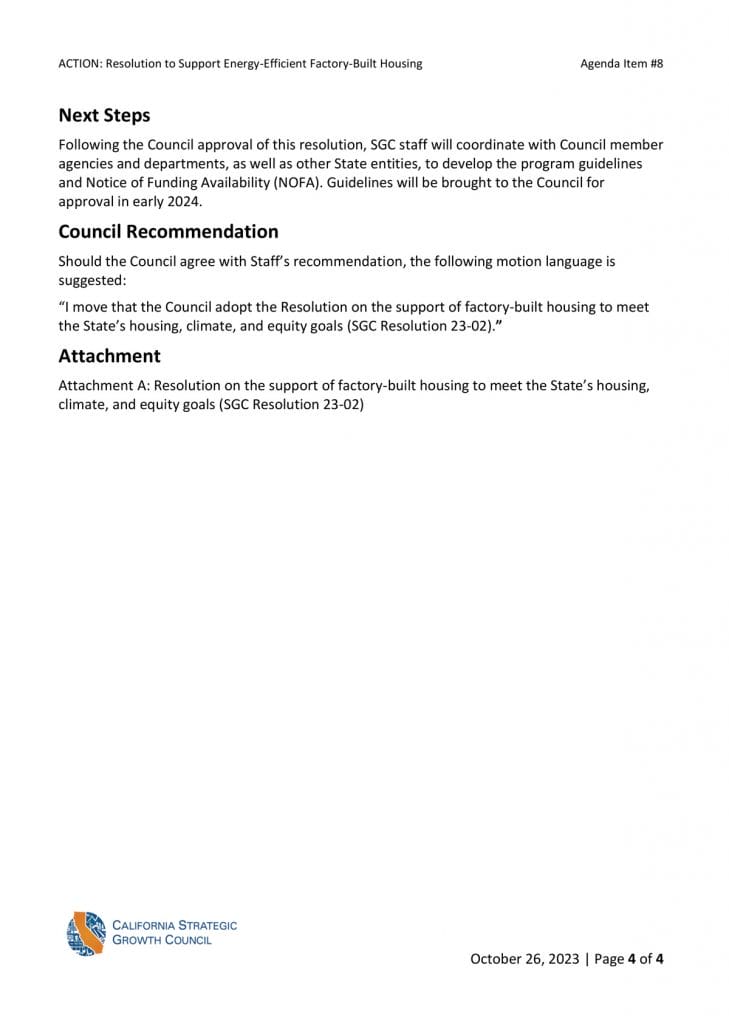Building at the Intersection of Housing Affordability & Energy Conservation
Inside California’s Climate-Conscious Push to Expand Factory-Built Housing
Tasked with looking at how the state of California can best house its growing population while meeting its aggressive energy, housing, transportation, land use, and equity goals, the California Strategic Growth Council (SGC) faces a slew of challenges. But, if the outlook of SGC Executive Director Lynn von Koch-Liebert is any indication, it’s only a matter of time before those challenges are successfully met.
“The SGC is unique in that we work as a bit of a think tank for the state,” says von Koch-Liebert. “We work closely with stakeholders and partners to understand challenges and issues across the state of California. Then we work through our programs and initiatives to really incubate solutions. Once we learn what’s working or not working, we take it to scale through promotion and support with our Council Members and their departments and agencies.”
“As Executive Director, I report to 10 Councilmembers, seven of whom are agency secretaries that oversee housing, transportation, conservation, environmental protection, natural resources, agricultural, land use and planning, and health and human services, as well as three public members” continues von Koch-Liebert. “We are tasked at looking at how we can help create healthy, thriving, and resilient communities by leaning into policy mandates and the expertise of our council members.
“In short, we take an intersectional approach to try and solve some of the trickiest challenges in the state of California.”
This action item, presented at the SGC’s October 2023 meeting, details the SGC’s “Resolution to support energy-efficient factory-built housing to meet the State’s climate, housing and equity goals” and identifies its next steps to help fund further development of factory-built housing. Reproduced with permission.
Leading the Way
“California has been a leader in thinking very aggressively and quantitatively about solutions to address climate change and build sustainable communities,” says von Koch-Liebert. “We have a couple key pieces of legislation: Assembly Bill 32, which set our greenhouse gas production levels and goals for reaching those levels by 2020. We have Senate Bill 375, which calls on municipal governance to think about how they can create sustainable community strategies to help reduce the emissions around the state. And then we also have a statewide housing plan that requires 2.5 million homes to be built by 2030, one million of which need to be for lower income households.”
California also boasts one of the nation’s most ambitious frameworks affecting the construction industry in the form of the California Green Building Standards Code, better known as CALGreen.
“CALGreen was established in 2008 as a voluntary code that became mandatory in 2010. CALGreen was developed to protect our environment, and to improve the health, safety, and general welfare of the public by enhancing the design and construction of buildings,” says von Koch-Liebert.
“What that really means is that construction projects must work very purposefully to reduce the negative environmental impacts and increase the positive impacts. So, it’s both sides of the coin. You’ll often see that coming through in planning and design, energy efficiency, water efficiency and conservation, material conservation, resource efficiency and environmental quality. And how this applies to factory-built housing in California, is that the CALGreen code is required for all our factory-built housing.”
“We concluded that there is a lot of mission alignment with offsite construction, such as cost savings, energy efficiency, and general practicality. But there were some real barriers to building new factories and expanding this industry in California. So, the [SGC’s] resolution was designed to pinpoint and target where the state could provide very specific support to factory owners who were considering building in California.”
~ Lynn von Koch-Liebert, executive director of California’s Strategic Growth Council
The Road to the SGC’s Recent Resolution
In October 2023, the Strategic Growth Council passed its “Resolution to support energy-efficient factory-built housing to meet the State’s climate, housing and equity goals,” which reflects the window of opportunity to access federal funding to implement projects, like factory-built housing, to meet the State’s ambitious policy goals.
“This resolution is really exciting”, says von Koch-Liebert. “It’s an acknowledgement that factory-built housing is an opportunity to accelerate progress towards state housing, climate equity, and energy goals.
“It directs our team to build a pilot program that supports the establishment and expansion of factory-built housing and manufacturing facilities in California, with a focus on applying for federal assistance and expanding clean energy infrastructure, creating jobs, and reducing emissions in California.”
There were many critical questions that had to be answered before the Resolution could be passed, however.
“Prior to the Council taking forward this resolution,” recalls von Koch-Liebert, “we held a series of roundtables with our partners at the California Business Consumer Services and Housing Agency to understand from industry partners: What is happening in this space? What is happening both domestically and internationally? What are the benefits and the values of factory-built construction? And what are some of the impediments to produce and build in California in a way that meets all of these requirements and gets to the outcomes we want?
With those questions identified, finding the answers brought clarity to the SGC…as well as opportunity for the offsite industry.
“One thing we quickly understood,” says von Koch-Liebert, “was that California is currently only producing about 5,000 factory-built units annually. We have a goal of 2.5 million units of housing in California, which means factory-built housing only represents a fraction of the housing that’s completed in California and even less of the projected demand.
“We concluded that there is a lot of mission alignment with offsite construction, such as cost savings, energy efficiency, and general practicality. But there were some real barriers to building new factories and expanding this industry in California. So, the resolution was designed to pinpoint and target where the state could provide very specific support to factory owners who were considering building in California.”
Leveraging Federal Dollars
The Inflation Reduction Act of 2022 (IRA), signed into law on August 16, 2022, directs new federal spending toward reducing carbon emissions, lowering healthcare costs, funding the Internal Revenue Service, and improving taxpayer compliance.
The act aims to catalyze investments in domestic manufacturing capacity, encourage procurement of critical supplies domestically or from free-trade partners, and jump-start R&D and commercialization of leading-edge technologies such as carbon capture and storage and clean hydrogen. It also allocates money directly to environmental justice priorities and requires recipients of many funding streams to demonstrate equity impacts.1
“This bill is game-changing,” says von Koch-Liebert. “The IRA represents the largest investment in combating climate change in US history. And we estimate that between the IRA and the Infrastructure Investment and Jobs Act (IIJA) which passed the prior year, nearly $200 billion in federal funding will make its way to California. Needless to say, this is just an astronomical amount of funding. And due to our ambitious and equity-focused climate goals, we are very well aligned to absorb these resources and put them to use in California.
“Due to unprecedented federal funding, we are strategizing methods to leverage state dollars to unlock federal funding and utilize these federal dollars to access even more private capital and investment. We are considering the pathways of these resources to understand how we can best use the smaller public resources to reach their full potential in our state.
In addition to the IRA, funding opportunities are available from federal agencies, including the Department of Energy.
“The Loan Program Office (LPO) at the US Department of Energy (DOE) offers an exciting opportunity all across the US: about $400 billion in loan availability through the Title 17 Clean Energy Financing Program,” says von Koch-Liebert. “The impact of this funding across clean energy infrastructure, greenhouse gas reduction, high-quality jobs, and community benefits is astonishing. But it is often an expensive and extensive process to access these resources.”
What is CALGreen?
In 2010, the California Building Standards Commission published the first version of the California Green Building Standards Code, also known as CALGreen, as Part 11 of Title 24 of the California Code of Regulations.
The Building Standards Commission describes the intent of the code as follows:
‘The purpose of this code is to improve public health, safety and general welfare by enhancing the design and construction of buildings. The goal is for positive environmental impact and encouraging sustainable construction practices in the following categories:
- Planning and design
- Energy efficiency
- Water efficiency and conservation
- Material conservation and resource efficiency
- Environmental quality'
The code was created to require sustainable building practices into all new buildings in California. It applies to both residential and commercial buildings.
CALGreen includes both mandatory and voluntary measures. Mandatory requirements involve water and energy efficiencies, indoor air quality and the use of sustainable building materials. Voluntary measures, on the other hand, are encouraged to enhance the requirements and/or add sustainable features, such as photo-voltaic solar, high-performance HVAC systems and energy efficient lighting fixtures.
On July 11, 2018, the California Air Resources Board announced in a press release that “greenhouse gas pollution in California fell below 1990 levels for the first time since emissions peaked in 2004 – an achievement roughly equal to taking 12 million cars off the road or saving 6 billion gallons of gasoline a year.” The development of CALGreen has been an important step toward more efficient and responsible building design which helped California meet the greenhouse gas reduction goal ahead of schedule.
There have been three updates to CALGreen since its inception. The current version is the 2022 code.
Adapted from CalGreen Energy Services
The SGC is focused on supporting industries that are looking to bring factory-built housing manufacturing facilities to California in two ways.
“First, SGC was designated as a State Energy Financing Institution (SEFI),” says von Koch-Liebert. “Projects that receive meaningful financial support from a SEFI are exempt from Title 17’s innovation requirement. The innovation requirement can be a barrier for projects that incorporate commercial technologies. By leveraging our status as SEFI, we can reduce barriers to these funds.
“The second is aligning our mission and process with the Department of Energy’s priorities to streamline opportunities for industry partners and maximize community benefits.”
In the Works: A Pilot, Pre-Development Fund
As an additional measure, SGC staff are developing a pilot, pre-development program to support factory-built housing manufacturers applying for LPO financing to expand or establish new manufacturing facilities in California. The pilot program will provide financial support to manufacturers applying for the Title 17 program. It will also incentivize multiple co-benefits across energy-efficiency, affordability, and workforce development.
“We know that having funding upfront—or taking the risk to get that finding—can be a barrier to expand or open new businesses in California that are creating factory-built housing,” says von Koch-Liebert. “We also understand getting through the application itself can be hard and that it helps to be part of a peer network that’s working through these things together. So, I think the pre-development aspect of this is important.”
“At the core, we’re providing financial support to factory-built housing manufacturers applying to federal funds and incentivizing community benefits to bring greater resources into California.”
Inspiration came after conversations with the offsite industry.
“SGC currently has several initiatives to support under-served communities across the state apply for federal funding for climate justice and resilience. We were looking for strategies to accelerate housing production, energy-efficiency, and reduce costs and realized the opportunity after listening to FBH manufacturers and understanding their impediments,” says von Koch-Liebert. “We looked at New York and some other states that are thinking through these processes so that we’re able to be very specific and intentional about where we can provide assistance. The criteria are still being determined, but our team is working quickly to get draft guidelines out to the public in the near future.”
Capitalizing on the Benefits of Offsite Construction
What can manufacturers do to put themselves in the best position for additional grants and funding?
“First is prioritizing the cost reductions that factory-built housing can provide,” says von Koch-Liebert. “Housing across the country is extremely expensive to build right now. It’s especially expensive in California. So, focusing on how to use those technologies and strategies to keep costs controlled so that those benefits can be passed on to owners and residents is really important.
“The second piece is working as part of the community you’re in. Figuring out how to structure and work collaboratively with the community that will be hosting the factory will help applicants be more competitive for many California programs. Similarly, funding from the Department of Energy requires a Community Benefit Agreement as part of each grant application. So, really putting community priorities front and center is helpful not only for Strategic Growth Council resources, but for Department of Energy resources as well.
“Finally,” concludes von Koch-Liebert, “factory-built housing in California needs to be built to CALGreen standards. So, factories need to continue to apply those high standards for energy efficiency and we encourage you to continue to look for new and innovative ways to advance energy savings and environmental outcomes in a factory setting.”
The Takeaway
Though California often leads the nation in energy- and climate-conserving initiatives, other states may well be in the position to follow suit. If, that is, there’s the political will.
“The first thing to do,” says von Koch-Libert, “is finally dispel the myth that we can’t have our cake and eat it too. I think one of the things that interests us so much about this industry is that you can tackle housing, you can tackle affordability, and you can tackle greenhouse gas reductions and energy efficiency all at once.
“Bringing together people from across those different sectors and working together is going to be critical to meet the many pressing needs not only in California, but nationally too.
“We have recognized at the Strategic Growth Council that it takes a lot of resources—time, expertise and financing—to be able to bring these complex projects together. I would encourage other states to think about how they can support community engagement and planning to help access implementation funding. We are seeing really good outcomes when we factor in the whole cycle from vision to project completion.”
For further questions, please contact: factorybuilthousing@sgc.ca.gov.
1 McKinsey & Company. The Inflation Reduction Act: Here’s what’s in it. https://www.mckinsey.com/industries/public-sector/our-insights/the-inflation-reduction-act-heres-whats-in-it. October 24, 2022.
About the Author: John McMullen, PCM, is the marketing director for the Modular Building Institute. You can reach him directly at mcmullen@modular.org or on LinkedIn.
More from Modular Advantage
AI, Faster Sets, and Automation: The Future of Modular is at World of Modular
While the modular building industry has long known that it can be an effective solution to increase affordable housing, the word is slowly spreading to more mainstream audiences. Three presentations at this year’s World of Modular in Las Vegas hope to provide insight and direction for those seeking a real solution to the crisis.
An Insider’s Guide to the 2025 World of Modular
The Modular Building Institute is bringing its global World of Modular (WOM) event back to Las Vegas, and with it comes some of the industry’s best opportunities for networking, business development, and education. Over the course of the conference’s four days, there will be numerous opportunities for attendees to connect, learn, and leverage event resources to get the most out of the conference.
Affordable Housing Now: The Industry’s Best Bring New Solutions to World of Modular
While the modular building industry has long known that it can be an effective solution to increase affordable housing, the word is slowly spreading to more mainstream audiences. Three presentations at this year’s World of Modular in Las Vegas hope to provide insight and direction for those seeking a real solution to the crisis.
Opportunities for Innovation in Modular Offsite Construction
Modular Offsite Construction has already shattered the myth that it only produces uninspired, box-like designs. Architectural innovations in module geometry, configurations, materials, and products make it possible to create visually stunning buildings without sacrificing functionality or efficiency.
Safe Modular Construction with Aerofilm Air Caster Transport
In collaboration with Aerofilm Systems, Heijmans developed innovative skids using air caster technology for moving modules easily and safely. These pallets are equipped with an auto-flow system, making operation extremely simple.
Miles, Modules, and Memes: Building a Modular Network One Flight at a Time
At the end of the day, social media is just another tool for building connections, and like any other tool, needs to be used skillfully to work properly. Use social media thoughtfully, and it will open doors to real opportunities and relationships you didn’t even see coming.
Falcon Structures: Thinking Inside the Box
Some of Falcon’s latest projects include creating container solutions for New York’s Central Park and an East Coast professional baseball team. More and more, Falcon is shipping out container bathrooms and locker rooms to improve traditionally difficult work environments, like those in oil and gas or construction.
UrbanBloc—From Passion to Industry Leader
UrbanBloc specializes in three main categories or markets – what they call “Phase 0” projects, amenities, and urban infill. Clients are often attracted to shipping containers because from a real estate perspective they are considered an asset. Having the flexibility to move and transport these assets allows owners to respond to different circumstances in a fluid manner that they can’t get with standard construction.
The Hospitality Game-Changer
“Hospitality is about more than just providing a service – it’s about delivering an experience,” says Anthony Halsch, CEO of ROXBOX. “And that’s where containers thrive. They allow us to create spaces that are unique, efficient, and sustainable.”
Container Conversions Counts on Simplicity to Provide Critical Solutions
Container Conversions has fabricated and developed thousands of containers for varied projects, including rental refrigeration options, offices, kitchens, temporary workplace housing, and mobile health clinics.














